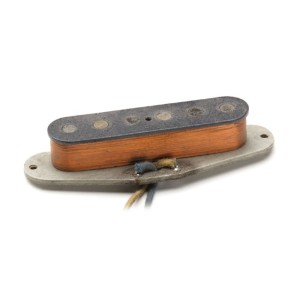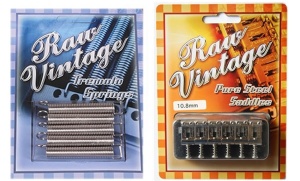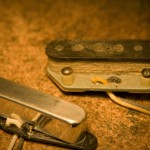Language
A Closer Look At Vintage Pickups
Vintage is a term that gets used a lot in the world of music gear. From classic guitars to iconic pedals, you don't have to go very far to bump into gear that prominently features the tag as a selling point. And the fact that new reissues keep coming out every year just goes to show how popular the vintage market really is. This is especially true when it comes to pickups. From Seymour Duncan to Lindy Fralin and more, there are a good amount of manufacturers out there that dedicate a lot of their resources into recreating some of the most iconic pickups ever made. Today, we're going to look at what exactly is a vintage pickup and few of the reasons why the original manufacturers went away from the classic formulas in the first place.
 Duncan Antiquity pickups use a custom aging process to recreate not only the tone of a vintage pickup but the look and feel as well![/caption]
Check out Duncan's Antiquity series for classic '50s era pickups of their Antiquity II for iconic '60s sets, featuring single-coils, P90s, Dogears, bass pickups and more. There are other companies who take a similar approach, such as Raw Vintage and Lindy Fralin, both of which offer a good variety if vintage pickups that can recreate iconic tones.
When it comes to pickups, a key component is signal output and tone. Take Fender's two legendary guitars for example; When the Telecaster and Stratocaster were first released, they came with bright sounding single-coil pickups that really made the guitars stand out in the music of the time. They also featured relatively low signal output compared to most of today's pickups. Each guitar's tone (sometimes called the Tele Chime and the Strat Quack) became an iconic representation of their era. As Fender kept updating their pickups, they began to change slightly over time. Compare the originals to what they use today on some of their modern setups and you can definitely hear the difference.
Duncan Antiquity pickups use a custom aging process to recreate not only the tone of a vintage pickup but the look and feel as well![/caption]
Check out Duncan's Antiquity series for classic '50s era pickups of their Antiquity II for iconic '60s sets, featuring single-coils, P90s, Dogears, bass pickups and more. There are other companies who take a similar approach, such as Raw Vintage and Lindy Fralin, both of which offer a good variety if vintage pickups that can recreate iconic tones.
When it comes to pickups, a key component is signal output and tone. Take Fender's two legendary guitars for example; When the Telecaster and Stratocaster were first released, they came with bright sounding single-coil pickups that really made the guitars stand out in the music of the time. They also featured relatively low signal output compared to most of today's pickups. Each guitar's tone (sometimes called the Tele Chime and the Strat Quack) became an iconic representation of their era. As Fender kept updating their pickups, they began to change slightly over time. Compare the originals to what they use today on some of their modern setups and you can definitely hear the difference.
 Aside from pickups, Raw Vintage also offer era-correct Tremolo Springs and Steel Saddles.[/caption]
The next big reason for the departure from vintage tone was simply catering to the current market. As times changed so did music and the gear used to create it. During the 60s, players began gravitating towards hotter and louder pickups with more sustain, so that’s what manufacturers began creating. Also, if a player wanted a more traditional vintage tone pickup, it wasn’t that difficult or expensive to go out and get one as there were plenty around. Today, we are decades removed from the vintage pickup era and like everything else, these original pickups have become much more expensive and harder to find. If vintage pickup tone is what you're after and don't need the true originals, manufacturers have become exceptionally talented in re-creating pickups that not only nail the tone of a vintage set but the look and feel of them as well.
Aside from pickups, Raw Vintage also offer era-correct Tremolo Springs and Steel Saddles.[/caption]
The next big reason for the departure from vintage tone was simply catering to the current market. As times changed so did music and the gear used to create it. During the 60s, players began gravitating towards hotter and louder pickups with more sustain, so that’s what manufacturers began creating. Also, if a player wanted a more traditional vintage tone pickup, it wasn’t that difficult or expensive to go out and get one as there were plenty around. Today, we are decades removed from the vintage pickup era and like everything else, these original pickups have become much more expensive and harder to find. If vintage pickup tone is what you're after and don't need the true originals, manufacturers have become exceptionally talented in re-creating pickups that not only nail the tone of a vintage set but the look and feel of them as well.
What Is A Vintage Pickup Anyway?
New gear marketed as vintage is simply one that has been made to sound, look and feel as close to the original model. While some pieces of gear simply aim to match specs and tone, there are others that go above and beyond that, going as far as using the exact methods and materials used in the originals. Take Duncan's Antiquity line for example. Not only are they made by hand, use the same materials and processes are the originals, they are 'aged' in such a way as to sound and look like a true five-decade-old pickup would (one that's been taken care of, of course). [caption id="attachment_4264" align="alignright" width="207"] Duncan Antiquity pickups use a custom aging process to recreate not only the tone of a vintage pickup but the look and feel as well![/caption]
Check out Duncan's Antiquity series for classic '50s era pickups of their Antiquity II for iconic '60s sets, featuring single-coils, P90s, Dogears, bass pickups and more. There are other companies who take a similar approach, such as Raw Vintage and Lindy Fralin, both of which offer a good variety if vintage pickups that can recreate iconic tones.
When it comes to pickups, a key component is signal output and tone. Take Fender's two legendary guitars for example; When the Telecaster and Stratocaster were first released, they came with bright sounding single-coil pickups that really made the guitars stand out in the music of the time. They also featured relatively low signal output compared to most of today's pickups. Each guitar's tone (sometimes called the Tele Chime and the Strat Quack) became an iconic representation of their era. As Fender kept updating their pickups, they began to change slightly over time. Compare the originals to what they use today on some of their modern setups and you can definitely hear the difference.
Duncan Antiquity pickups use a custom aging process to recreate not only the tone of a vintage pickup but the look and feel as well![/caption]
Check out Duncan's Antiquity series for classic '50s era pickups of their Antiquity II for iconic '60s sets, featuring single-coils, P90s, Dogears, bass pickups and more. There are other companies who take a similar approach, such as Raw Vintage and Lindy Fralin, both of which offer a good variety if vintage pickups that can recreate iconic tones.
When it comes to pickups, a key component is signal output and tone. Take Fender's two legendary guitars for example; When the Telecaster and Stratocaster were first released, they came with bright sounding single-coil pickups that really made the guitars stand out in the music of the time. They also featured relatively low signal output compared to most of today's pickups. Each guitar's tone (sometimes called the Tele Chime and the Strat Quack) became an iconic representation of their era. As Fender kept updating their pickups, they began to change slightly over time. Compare the originals to what they use today on some of their modern setups and you can definitely hear the difference.
A Lost Formula
You might have heard an old player chime "they just don't make them like they used to." Whether it was intentional or not, there's actually a lot of truth to that saying when it comes to vintage pickups. After several years of manufacturers gradually changing the process behind creating their pickups, they lost a few of the innate subtleties that players loved most about them. Most of the time, these changes were made little by little in order to modernize or improve on the design. As time went on, these changes added up to a drastic departure from the original pickup’s tone, for better or worse. Other times, they were simply the victims of simple economics: sacrificing some of the pickup’s shine in order to be able to better mass produce them or keep costs at a reasonable point. It should also be noted that around this time, many of the biggest names in music – such as Fender, Gibson and Gretsch – all fell into the hands of brand new owners. And with this, many changes were made to several aspects of their production methods which also affected their pickups. [caption id="attachment_4268" align="alignright" width="300"] Aside from pickups, Raw Vintage also offer era-correct Tremolo Springs and Steel Saddles.[/caption]
The next big reason for the departure from vintage tone was simply catering to the current market. As times changed so did music and the gear used to create it. During the 60s, players began gravitating towards hotter and louder pickups with more sustain, so that’s what manufacturers began creating. Also, if a player wanted a more traditional vintage tone pickup, it wasn’t that difficult or expensive to go out and get one as there were plenty around. Today, we are decades removed from the vintage pickup era and like everything else, these original pickups have become much more expensive and harder to find. If vintage pickup tone is what you're after and don't need the true originals, manufacturers have become exceptionally talented in re-creating pickups that not only nail the tone of a vintage set but the look and feel of them as well.
Aside from pickups, Raw Vintage also offer era-correct Tremolo Springs and Steel Saddles.[/caption]
The next big reason for the departure from vintage tone was simply catering to the current market. As times changed so did music and the gear used to create it. During the 60s, players began gravitating towards hotter and louder pickups with more sustain, so that’s what manufacturers began creating. Also, if a player wanted a more traditional vintage tone pickup, it wasn’t that difficult or expensive to go out and get one as there were plenty around. Today, we are decades removed from the vintage pickup era and like everything else, these original pickups have become much more expensive and harder to find. If vintage pickup tone is what you're after and don't need the true originals, manufacturers have become exceptionally talented in re-creating pickups that not only nail the tone of a vintage set but the look and feel of them as well.

